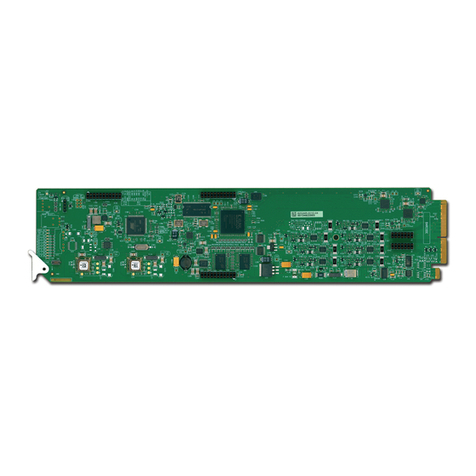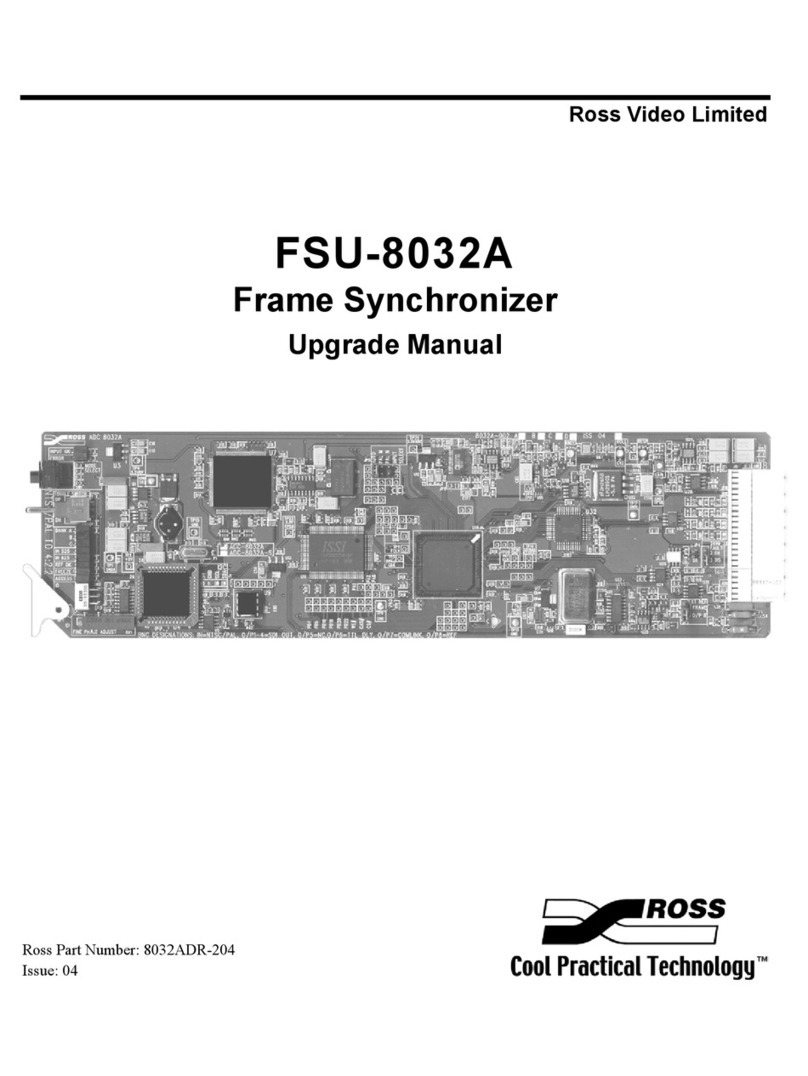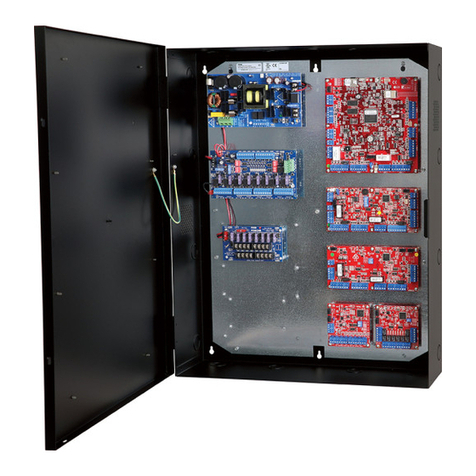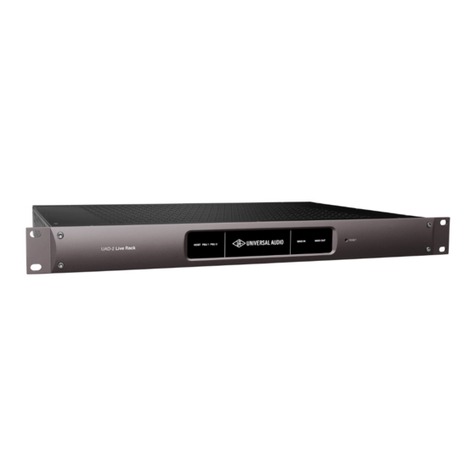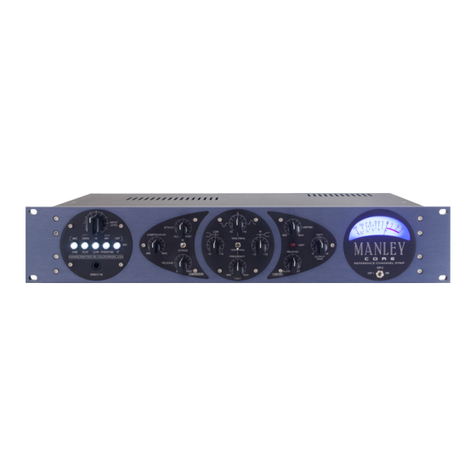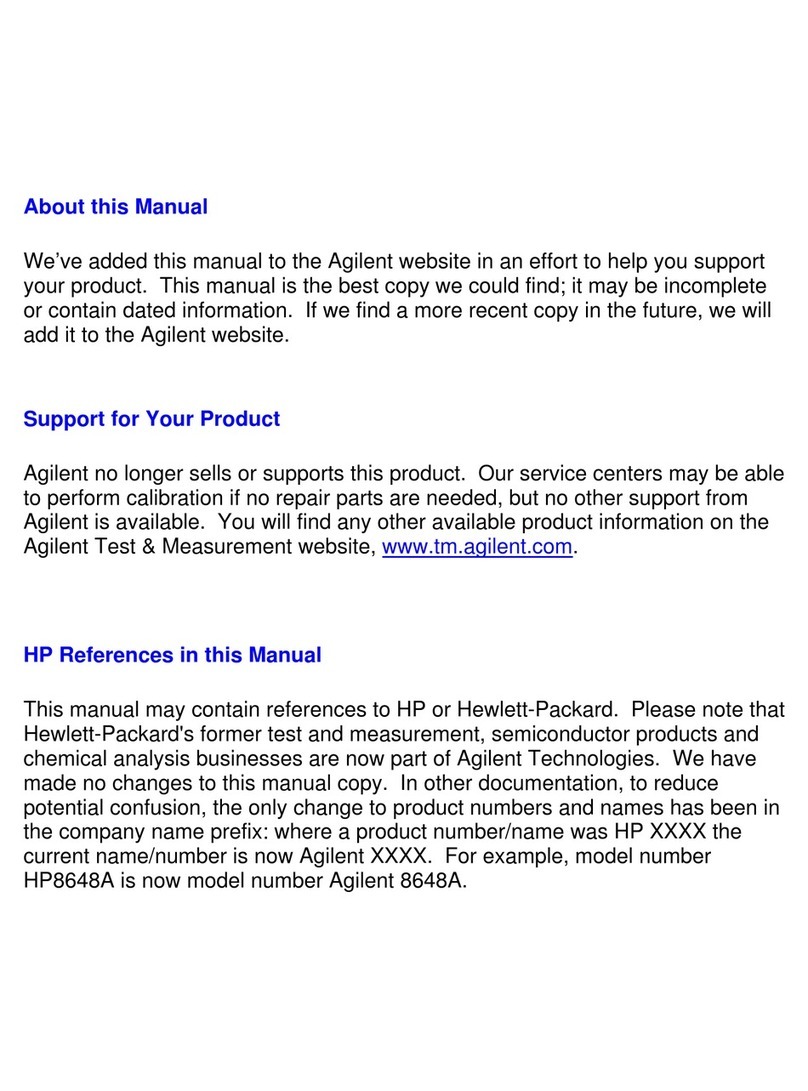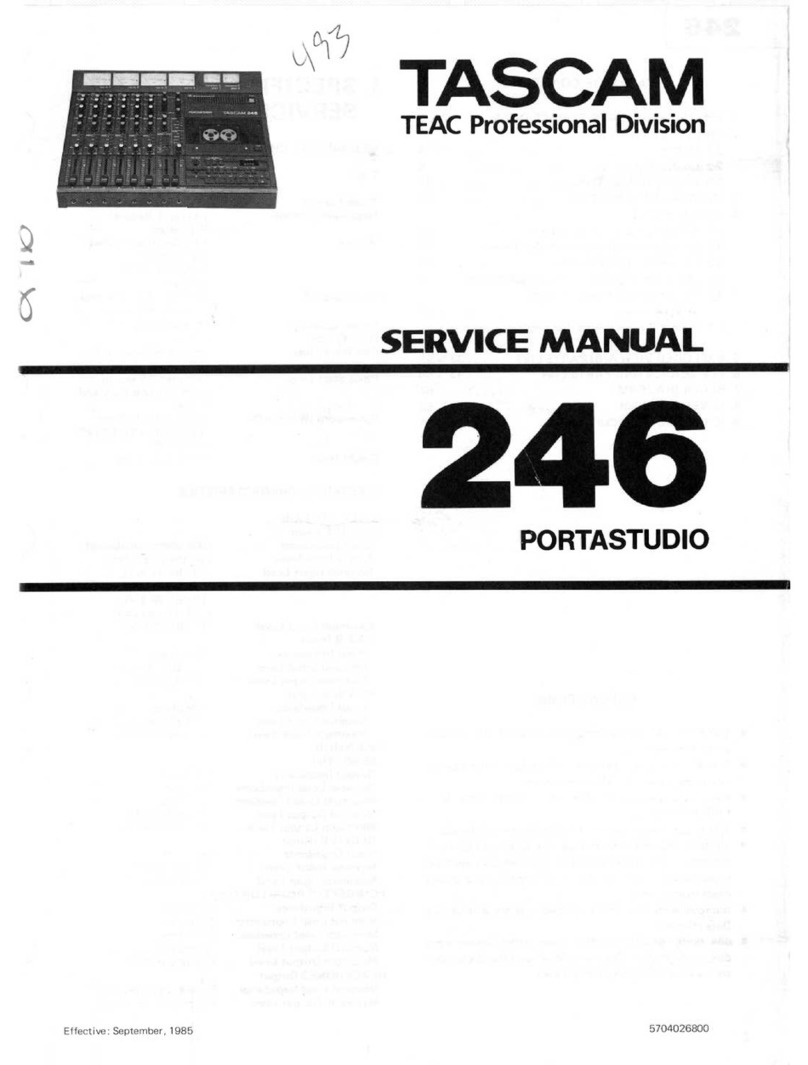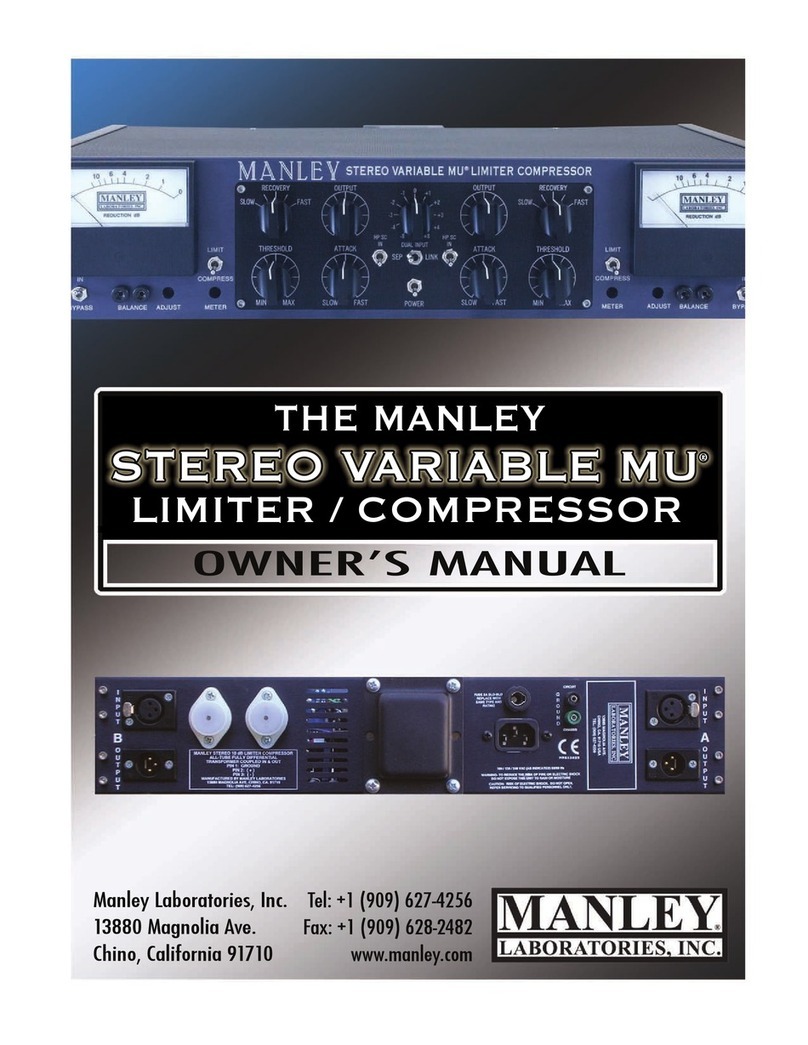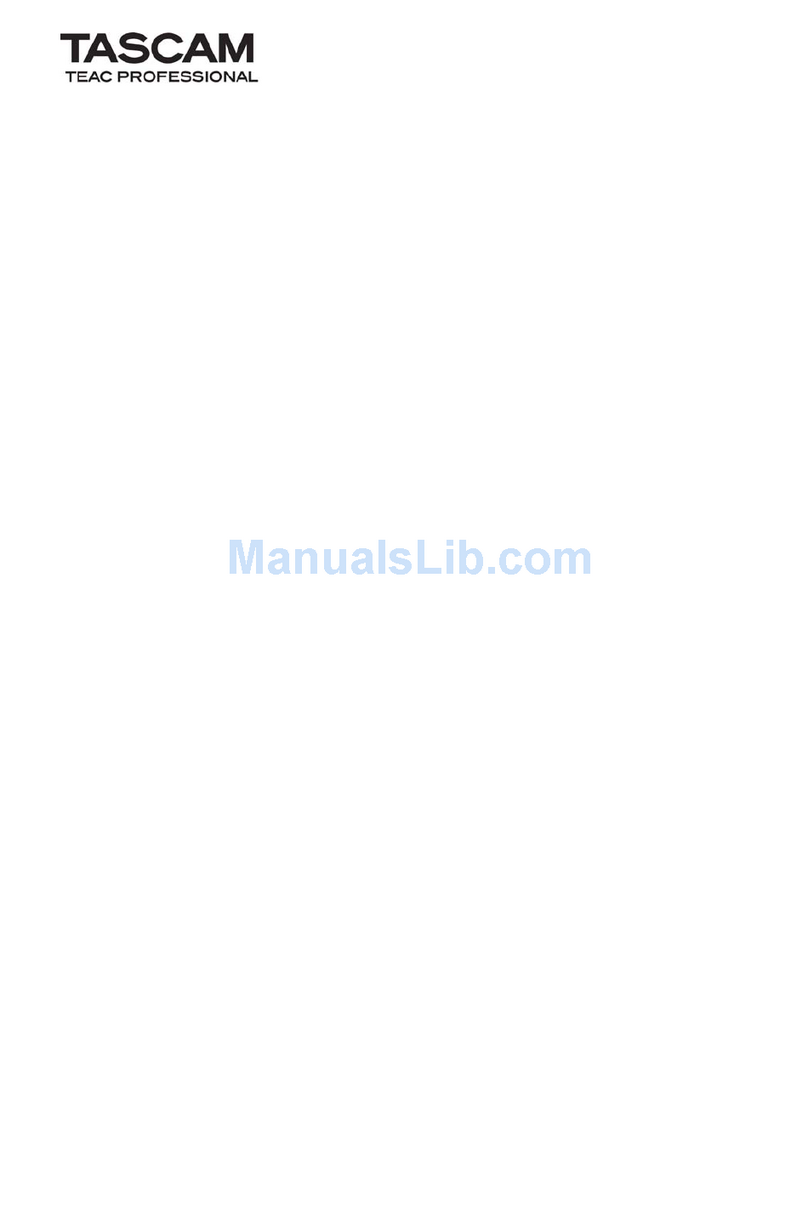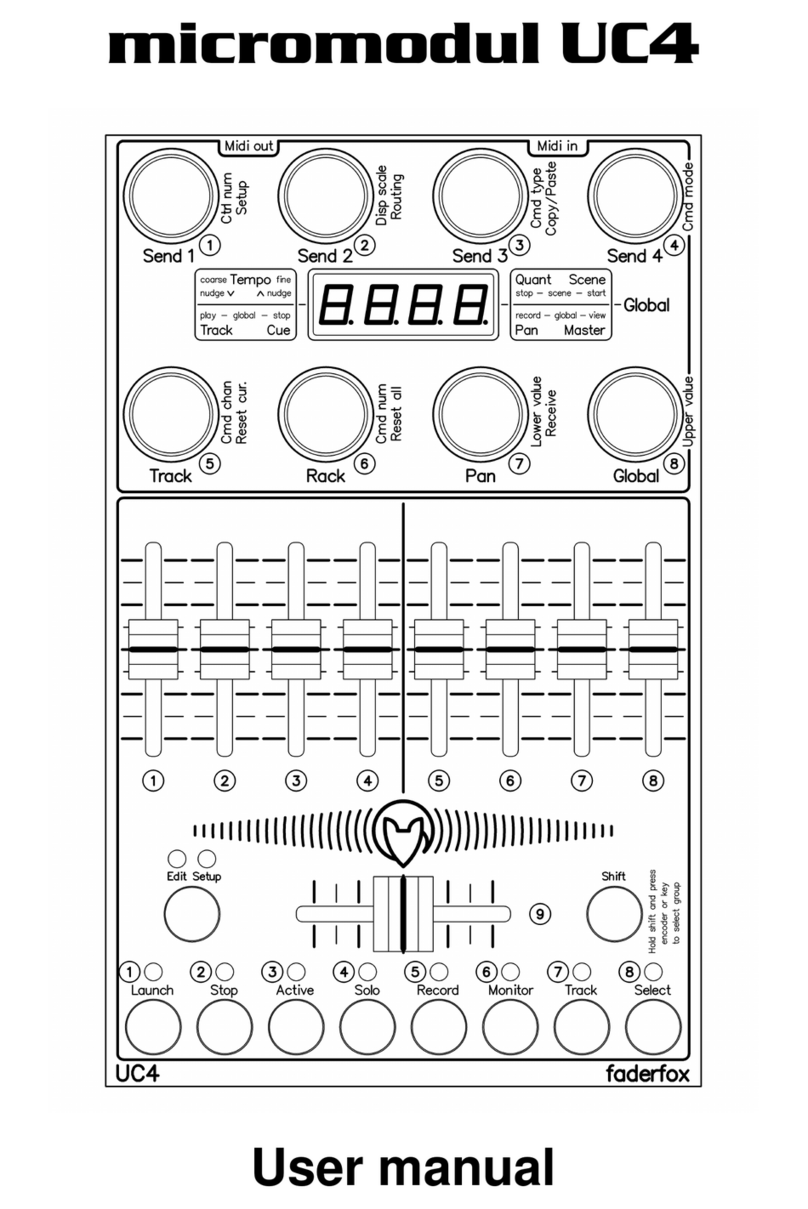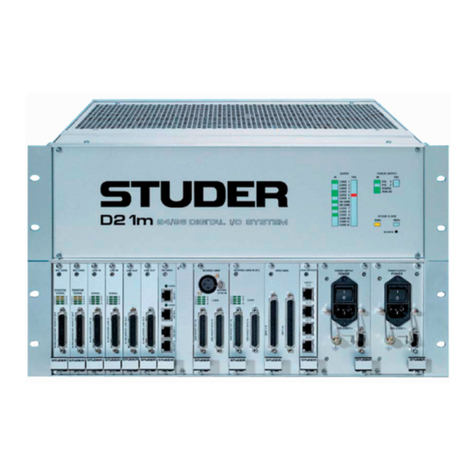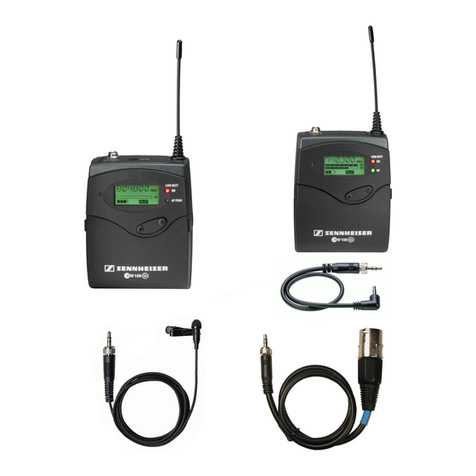Ross openGear SFS-8221 User manual

Ross Video Limited
SFS-8221
Single Channel MD-SDI Frame Synchronizer
User Manual
Ross Part Number: 8221DR-004
Issue: 01C

SFS-8221 •Single Channel MD-SDI Frame Synchronizer User Manual
• Ross Part Number: 8221DR-004
• Document Issue: 01C
• Printed in Canada.
The information contained in this User Manual is subject to change without notice or obligation.
Copyright
© 2007 Ross Video Limited. All rights reserved.
Contents of this publication may not be reproduced in any form without the written permission of
openGear. Reproduction or reverse engineering of copyrighted software is prohibited.
Notice
The material in this manual is furnished for informational use only. It is subject to change without
notice and should not be construed as a commitment by Ross Video Limited. Ross Video Limited
assumes no responsibility or liability for errors or inaccuracies that may appear in this manual.
Trademarks
• is a registered trademark of Ross Video Limited.
• is a registered trademark of Ross Video Limited.
• Ross, ROSS, ROSS®, and MLE are registered trademarks of Ross Video Limited.
• All other product names and any registered and unregistered trademarks mentioned in
this manual are used for identification purposes only and remain the exclusive property of
their respective owners.

Important Regulatory and Safety Notices
Before using this product and any associated equipment, refer to the “Important Safety Instructions”
listed below so as to avoid personnel injury and to prevent product damage.
Products may require specific equipment, and /or installation procedures be carried out to satisfy
certain regulatory compliance requirements. Notices have been included in this publication to call
attention to these Specific requirements.
Symbol Meanings
This symbol on the equipment refers you to important operating and maintenance
(servicing) instructions within the Product Manual Documentation. Failure to heed
this information may present a major risk of damage or injury to persons or
equipment.
Warning
The symbol with the word “Warning” within the equipment manual indicates a
potentially hazardous situation, which if not avoided, could result in death or serious
injury.
Caution
The symbol with the word “Caution” within the equipment manual indicates a
potentially hazardous situation, which if not avoided, may result in minor or
moderate injury. It may also be used to alert against unsafe practices.
Notice
The symbol with the word “Notice” within the equipment manual indicates a
situation, which if not avoided, may result in major or minor equipment damage or a
situation which could place the equipment in a non-compliant operating state.
ESD
Susceptibility
This symbol is used to alert the user that an electrical or electronic device or
assembly is susceptible to damage from an ESD event.
Important Safety Instructions
Caution
This product is intended to be a component product of the openGear series frame.
Refer to the openGear series frame User Manual for important safety instructions
regarding the proper installation and safe operation of the frame as well as it’s
component products.
Warning
Certain parts of this equipment namely the power supply area still present a safety
hazard, with the power switch in the OFF position. To avoid electrical shock,
disconnect all A/C power cords from the chassis' rear appliance connectors before
servicing this area.
Warning
Service barriers within this product are intended to protect the operator and service
personnel from hazardous voltages. For continued safety, replace all barriers after
any servicing.
This product contains safety critical parts, which if incorrectly replaced may present
a risk of fire or electrical shock. Components contained within the product’s power
supplies and power supply area, are not intended to be customer serviced and should
be returned to the factory for repair.
To reduce the risk of fire, replacement fuses must be the same type and rating.
Only use attachments/accessories specified by the manufacturer.

EMC Notices
US FCC Part 15
This equipment has been tested and found to comply with the limits for a class A Digital device,
pursuant to part 15 of the FCC Rules. These limits are designed to provide reasonable protection
against harmful interference when the equipment is operated in a commercial environment. This
equipment generates, uses, and can radiate radio frequency energy and, if not installed and used in
accordance with the instruction manual, may cause harmful interference to radio communications.
Operation of this equipment in a residential area is likely to cause harmful interference in which case
users will be required to correct the interference at their own expense.
Notice
Changes or modifications to this equipment not expressly approved by Ross Video
Ltd. could void the user’s authority to operate this equipment.
CANADA
This Class “A” digital apparatus complies with Canadian ICES-003.
Cet appareil numerique de classe “A” est conforme à la norme NMB-003 du Canada.
EUROPE
This equipment is in compliance with the essential requirements and other relevant provisions of CE
Directive 93/68/EEC.
INTERNATIONAL
This equipment has been tested to CISPR 22:1997 along with amendments A1:2000 and A2:2002 and
found to comply with the limits for a Class A Digital device.
Notice
This is a Class A product. In domestic environments this product may cause radio
interference in which case the user may have to take adequate measures.
Maintenance/User Serviceable Parts
Routine maintenance to this openGear product is not required. This product contains no user
serviceable parts. If the module does not appear to be working properly, please contact Technical
Support using the numbers listed under the “Contact Us” section on the last page of this manual. All
RossGear products are covered by a generous 5-year warranty and will be repaired without charge for
materials or labor within this period. See the “Warranty and Repair Policy” section in this manual for
details.

Environmental Information
The equipment that you purchased required the extraction and use of natural resources for its
production. It may contain hazardous substances that could impact health and the environment.
To avoid the potential release of those substances into the environment and to diminish the need for
the extraction of natural resources, Ross Video encourages you to use the appropriate take-back
systems. These systems will reuse or recycle most of the materials from your end-of-life equipment in
an environmentally friendly and health conscious manner.
The crossed-out wheeled bin symbol invites you to use these systems.
If you need more information on the collection, reuse, and recycling systems, please contact your local
or regional waste administration.
You can also contact Ross Video for more information on the environmental performances of our
products.


SFS-8221 User Manual (Iss. 01C) Contents •i
Contents
Introduction 1-1
In This Chapter .......................................................................................................................1-1
A Word of Thanks....................................................................................................1-1
Overview ..................................................................................................................1-2
Functional Block Diagram .......................................................................................1-2
Functional Overview ................................................................................................1-3
Frame Synchronizer Operation.................................................................................1-4
Frame Delay Operation ............................................................................................1-4
Minimum Delay through the SFS-8221 ...................................................................1-5
Video Output Resync ...............................................................................................1-5
Features ....................................................................................................................1-6
Documentation Terms ..............................................................................................1-6
Installation and Setup 2-1
In This Chapter .......................................................................................................................2-1
Static Discharge........................................................................................................2-1
Unpacking ................................................................................................................2-1
Local Reference Termination Jumper ......................................................................2-2
Rear Module Installation (Optional) ........................................................................2-2
Board Installation .....................................................................................................2-4
BNC Labels ..............................................................................................................2-4
Cable Connections....................................................................................................2-5
User Controls 3-1
In This Chapter .......................................................................................................................3-1
User Controls............................................................................................................3-1
LEDs.........................................................................................................................3-3
Menus 4-1
In This Chapter .......................................................................................................................4-1
Layout and Navigation .............................................................................................4-1
Using the Menus.......................................................................................................4-2
The Menu System.....................................................................................................4-5
Setup.........................................................................................................................4-8
Timing ......................................................................................................................4-9
Output.....................................................................................................................4-10
Proc Amp................................................................................................................4-11
Card Information ....................................................................................................4-12
Hardware ................................................................................................................4-12
Signal......................................................................................................................4-13
Exit .........................................................................................................................4-14

ii •Contents SFS-8221 User Manual (Iss. 01C)
Specifications 5-1
In This Chapter ...................................................................................................................... 5-1
Technical Specifications.......................................................................................... 5-2
Service Information 6-1
In This Chapter ...................................................................................................................... 6-1
Troubleshooting Checklist....................................................................................... 6-1
Power LED Conditions............................................................................................ 6-2
Bootload Button....................................................................................................... 6-2
Warranty and Repair Policy .................................................................................... 6-2
In Case of Problems................................................................................................. 6-3
Ordering Information 7-1
In This Chapter ...................................................................................................................... 7-1

SFS-8221 User Manual (Iss. 01C) Introduction •1-1
Introduction
In This Chapter
This chapter contains the following sections:
• A Word of Thanks
• Overview
• Functional Block Diagram
• Functional Overview
• Frame Synchronizer Operation
• Frame Delay Operation
• Minimum Delay through the SFS-8221
• Video Output Resync
• Features
• Documentation Terms
A Word of Thanks
Congratulations on choosing the openGear SFS-8221 Single Channel MD-SDI Frame
Synchronizer. The SFS-8221 is part of a full line of Digital Products within the openGear Terminal
Equipment family of products, backed by Ross Video’s experience in engineering and design expertise
since 1974.
You will be pleased at how easily your new SFS-8221 fits into your overall working environment.
Equally pleasing is the product quality, reliability, and functionality. Thank you for joining the group
of worldwide satisfied Ross Video customers!
Should you have a question pertaining to the installation or operation of your SFS-8221, please contact
us at the numbers listed on the back cover of this manual. Our technical support staff is always
available for consultation, training, or service.

1-2 •Introduction SFS-8221 User Manual (Iss. 01C)
Overview
The SFS-8221 is a single channel Multi-Definition SDI frame synchronizer designed for use in both
standard and high definition environments.
The SFS-8221 supports popular standard-definition and high-definition video formats including 480i,
720p, and 1080i. The format of incoming video is automatically detected, simplifying system setup.
The SFS-8221 accepts an SDI signal of either standard definition (270 Mb/s) or high definition (1.485
Gb/s), automatically equalizing for cable loss and providing a reclocked SDI output. In Frame Sync
mode, the video is synchronized to either a frame-wide reference or a local reference. In Frame Delay
mode, further flexibility in resolving system timing problems is available, as an additional fixed delay
can be added to the video.
The openGear frames support a distributed frame reference, allowing a single incoming reference sync
signal to feed timing information to all modules in a frame. Thus, a single composite or tri-level sync
signal can be used for multiple cards. Alternatively, each card accepts an additional local reference
signal providing additional system timing flexibility.
For simplified setup and monitoring, the SFS-8221 Frame Synchronizer offers a unique Heads-Up
Display on a separate composite monitoring output. When activated, card status and parameters can be
viewed and adjusted using the card-mounted finger joystick and an easy to use menu system.
The SFS-8221 is housed in the openGear DFR-8310-C frame.
Functional Block Diagram
Figure 1. Simplified Block Diagram of SFS-8221 Functions

SFS-8221 User Manual (Iss. 01C) Introduction •1-3
Functional Overview
The SFS-8221will typically be used in a broadcast studio for one or both of the following functions:
• Frame delay for timing alignment
• Frame synchronizer for frame rate conversion
The following diagram demonstrates the operation of the SFS-8221.
Selected
Reference
Video Input
Video Output
Frame N Frame N+1 Frame N+2
Frame N + F Frame N+1 + F Frame N+2 + F
Minimum Input to Output Delay (>= 1 Line)
Output Delay: Frame (F), Vertical (V) and Horizontal (H) Delay
V + H
The following elements are illustrated in the diagram:
• Up Arrow
The up arrow represents the start of a video frame.
• Selected Reference
The selected reference can be one of the four possible options:
~ Frame 1 analog reference from the openGear DFR-8310-C frame
~ Frame 2 analog reference from the openGear DFR-8310-C frame
~ Local analog reference from BNC-10 of the rear module
~ Digital reference extracted from the SDI video input
Note that when selecting the digital reference extracted from the SDI video input, the above
timing diagram should be redrawn with the up arrows of the reference and the video input aligned
vertically.
• Video Input
The SDI video input is derived from BNC 2. When the video input signal is not locked to the
selected reference, the video input start of frame will drift compared to the reference. This can be
visualized by sliding the up arrows of the video input diagram to the left if the video input frame
rate is slower than the reference, or to the right if it is higher.
• Video Output
The processed SDI video output is available on BNCs 6 and 8 while there is a reclocked output on
BNC 4. The video output timing is always locked to the selected reference. The SFS-8221 allows
the user to set the relative position of the video output start of frame as an offset to the reference.
With the adjustable V and H parameters, the user can set the relative offset anywhere in the
reference frame timing, in increments of 1 line for vertical timing and 1 pixel for horizontal
timing.

1-4 •Introduction SFS-8221 User Manual (Iss. 01C)
• Frame Delay (F)
The value Frepresents the number of frames of delay that can be adjusted using the Heads-Up
Display menus on the monitoring output, or by using DashBoard Lite. The parameter can be
adjusted from 0 to a maximum limit that depends on the video format. For example, with a 480i
format, the parameter can be adjusted from 0 to 104 frames, in increments of 1 frame. A value of
0 means that the delay thru the SFS-8221 will be between 0 and 1 frame.
• Vertical Delay (V)
The value V represents the number of lines of delay that we can adjust as above using the
monitoring output, or by using DashBoard Lite. The parameter can be adjusted from 0 to a
maximum limit that depends on the video format. For example, with a 480i format, the parameter
can be adjusted from 0 to 524 lines, in increments of 1 line.
• Horizontal Delay (H)
The value H represents the number of pixels of delay that we can adjust the monitoring output
using the Heads-Up Display or with DashBoard Lite. The parameter can be adjusted from 0 to a
maximum limit that depends on the video format. For example, with a 480i format, the parameter
can be adjusted from 0 to 857 pixels, in increments of 1 pixel.
Frame Synchronizer Operation
If the Reference selection is set to Frame 1, Frame 2 or Local, and if the reference present is valid, the
SFS-8221 is automatically set to Frame Sync mode. If a valid reference is selected, and then
removed, the SFS-8221 will reamin in Frame Sync mode but will flywheel. This means that the
SFS-8221 will be dropping or repeating the display of some video input frames as necessary to keep
the input to output delay within the specified range of F to F+1 frames delay. The frame drop/repeat
occurs whenever the video input frame start point crosses over the video output frame start point. The
SFS-8221 has built-in hysteresis to avoid visible artifacts if the input and output timing alignment
oscillates around the drop/repeat cross-over point. When selecting one of the three analog references
(Frame 1, Frame 2, or Local), the SFS-8221 will report in the Timing Mode menu that it is operating
in Frame Sync mode.
Frame Delay Operation
When the video input signal is locked to the selected external reference, the SFS-8221 will operate in
Frame Delay mode. In this mode of operation, SFS-8221 will not be adding or dropping any frames,
and all video input frames will be displayed “F” number of frames after they are received onto the
card. When selecting the digital reference from the SDI video input, Frame Sync mode will be
unavailable, and Frame Delay mode will be reflected in the Timing Mode menu.
It is important to understand that when the SFS-8221 is using the digital reference extracted from the
SDI video input, the SDI video input signal must be stable at all times. Any glitches on this signal will
likely cause the SFS-8221 video output to stop and restart, basically re-syncing the video output to the
digital reference. Therefore, in practical applications, it will not be possible to switch the SDI video
input from an upstream router without re-syncing the SFS-8221 video output. For this reason, it is
strongly recommended not to use the SDI input as the reference, and to select instead one of the analog
references. If the SDI video input signal happens to be locked to the selected analog reference, the
SFS will be effectively operating in frame delay mode, as no frames drop/repeat will be occurring.

SFS-8221 User Manual (Iss. 01C) Introduction •1-5
Minimum Delay through the SFS-8221
The SDI video input is stored in frame buffer memory and is read from the frame buffer at a later time.
Going through the frame buffer requires a minimum time and the SFS-8221 is specified as having a
minimum delay of 1 line. This means that if the video input frame start position is less that one line
before the video output frame start, then the SFS-8221 will automatically insert one frame of delay if
in frame synchronize mode.
Although it is possible to set the input to output delay to the minimum of one line (F=0, V=1, H=0), it
is recommended to operate the SFS-8221 with a delay of a least 1 full frame (F=1, V=0, H=0 or more)
to allow the filtering of corrupted video input frames.
When set to a delay of less than one frame, the SFS-8221 is actually displaying an underlayed stream
of the incoming video. This means that if the incoming video frame is corrupted for any reasons (such
as loss of input, untimed source switching, noisy input, etc), then the SFS-8221 will be unable to mask
the corrupted incoming video and will display the invalid video frame. Regardless of the video input
state, the video output of the SFS-8221 will be properly formatted with continuous TRS codes, only
the blanking and active video content may be corrupted for one visible frame. For example, on a loss
of input signal, the SFS-8221 would display one corrupted frame and would then either go to black or
would revert to display the last known good frame, as chosen by the user menu.
When set to a delay of one frame or more, the SFS-8221 can detect a corrupted video input frame and
avoids displaying it by freezing the previous stable video output frame the input signal is stable again.
Video Output Resync
The SFS-8221 provides a valid video output frame with formatted TRS codes. In certain conditions,
however, the video output of the SFS will have to be resynchronized and while doing so, the SFS-
8221 will not be able to maintain a valid output. The following conditions will force a resync of the
video output of the SFS-8221:
• Reference loss and reference re-acquired
To provide a stable output, the SFS-8221 must have a stable reference.
• Changes in the vertical (V) or horizontal (H) delay parameters
A parameter change will force the SFS output to reset and restart the video output with the
specified V/H offset. Note that changing the number of frames (F) of delay will not reset the
output as long as the V/H parameters are constant.
• Video input format change
The SFS-8221 will auto-detect the video input format and if it is recognized as one of its
supported formats, it will set its output to match it. While doing so, the output will be reset and
restarted.

1-6 •Introduction SFS-8221 User Manual (Iss. 01C)
Features
The following features make the SFS-8221 the best solution for timing applications in standard
definition and high definition environments:
• Single Channel MD-SDI Frame Synchronizer
• Supports the following formats:
• 480i/59.94
• 720p/59.94
• 1080i/59.94
• 576i/50
• 720p/50
• 1080i/50
• Automatically detects the incoming video format
• Can add additional fixed delay to solve system timing problems
• Capable of adding frames of delay at SD-SDI rates, in 720p, and in 1080i
• Ancillary data can be preserved or blanked as desired, with independent control of
HANC and VANC
• V bit placement can be moved to line 10 or line 20, or set to follow incoming video
• Provides Proc Amp controls, such as video gain, chroma gain, luma gain, and black
level offset
• Composite monitoring output with Heads-Up Display menu system
• One reclocked and two processed SDI outputs
• 5 year transferable warranty
• Fits openGear DFR-8310-C frames
Documentation Terms
The following terms are used throughout this guide:
• “Frame” refers to the DFR-8310-C frame that houses the SFS-8221 card.
• All references to the DFR-8310-C also include the DFR-8310-C-BNC version with
the fixed 100-BNC rear module. See the respective User Manuals for details.
• “Operator” and “User” both refer to the person who uses the SFS-8221.
• “Board”, and “Card” all refer to the SFS-8221 card itself, including all components
and switches.
• “System” and “Video system” refers to the mix of interconnected production and
terminal equipment in which the SFS-8221 operates.

SFS-8221 User Manual (Iss. 01C) Installation and Setup •2-1
Installation and Setup
In This Chapter
This chapter contains the following sections:
• Static Discharge
• Unpacking
• Local Reference Termination Jumper
• Rear Module Installation (Optional)
• Board Installation
• BNC Labels
• Cable Connections
Static Discharge
Whenever handling the SFS-8221 and other related equipment, please observe all static discharge
precautions as described in the following note:
ESD
Susceptibility
Static discharge can cause serious damage to sensitive
semiconductor devices. Avoid handling circuit boards in high
static environments such as carpeted areas, and when wearing
synthetic fiber clothing. Always exercise proper grounding
precautions when working on circuit boards and related
equipment.
Unpacking
Unpack each SFS-8221 you received from the shipping container, and check the contents to ensure
that all items are included. If any items are missing or damaged, contact your sales representative or
Ross Video directly.

2-2 •Installation and Setup SFS-8221 User Manual (Iss. 01C)
Local Reference Termination Jumper
If you have elected to use a local reference signal, it must be terminated on the card with jumper J20.
To terminate the local reference on the card, see Figure 2 below:
• Install jumper J20 in the TERM position (the rightmost two pins).
The following figure shows the reference termination jumper location on the SFS-8221.
J20
Reference
Termination
Figure 2. Reference Termination Jumper
Rear Module Installation (Optional)
If you are installing the SFS-8221 in an openGear DFR-8310-C-BNC frame, skip this section.
If you received an RM-8300-B Rear I/O Module with your SFS-8221, you will need to install the I/O
module in your DFR-8310-C frame before you can install the SFS-8221 in the frame, or connect
cables to the slot you have chosen for the SFS-8221.
Use the following procedure to install the rear module in an openGear DFR-8310-C digital distribution
frame:
1. Refer to the openGear DFR-8310-C frame User Manual, to ensure that the frame is
properly installed according to instructions.
2. On the rear of the DFR-8310-C, locate the card frame slot.
3. If there is no Blocker Plate installed, proceed to the next step. Remove the Blocker
Plate from the rear of the slot you have chosen for the SFS-8221 installation.
4. As shown in Figure 3, seat the bottom of the rear module in the seating slot at the
base of the frame’s back plane.

SFS-8221 User Manual (Iss. 01C) Installation and Setup •2-3
Figure 3. Rear Module Installation (SFS-8221 not shown)
5. Align the top hole of the rear module with the screw hole on the top edge of the
DFR-8310-C back plane.
6. Using a Phillips driver and the supplied screw, fasten the rear module to the DFR-
8310-C back plane. Do not over tighten.
7. Ensure proper frame cooling and ventilation by having all rear frame slots covered
with rear I/O modules or blank metal plates. If you need blanks, refer to the chapter,
“Ordering Information” in the DFR-8310-C manual, and contact your openGear
sales representative.
This completes the procedure for installing the Rear I/O Module in an openGear DFR-8310-C digital
distribution frame.

2-4 •Installation and Setup SFS-8221 User Manual (Iss. 01C)
Board Installation
Use the following procedure to install the SFS-8221 in an openGear DFR-8310-C distribution frame
with cooling fans (DFR-8310-C, or DFR-8310-C-BNC):
Notice
Due to power consumption and heat dissipation requirements,
the SFS-8221 must only be installed in a frame with the cooling
fan option installed.
1. Refer to the User Manual of the openGear 8300 series frame to ensure that the frame
is properly installed according to instructions.
2. A maximum of nine SFS-8221 modules can be installed in a DFR-8310-C frame.
Important Do not populate Slot 10 with an SFS-8221. Attempting to populate Slot 10
and next to any installed MFC-8310(-N) optional cards may damage the
optional cards, the SFS-8221, or both.
3. After selecting the desired frame installation slot, hold the SFS-8221 card by the
edges and carefully align the card edges with the slots in the frame. Then fully insert
the card into the frame until the rear connection plugs are properly seated on the
midplane and rear modules.
This completes the procedure for installing the SFS-8221 in a DFR-8310-C distribution frame with
cooling fans.
BNC Labels
Affix the supplied BNC label, as per the included instructions, to the BNC area on the rear of the rack
frame.

SFS-8221 User Manual (Iss. 01C) Installation and Setup •2-5
Cable Connections
This section provides information for connecting cables to the installed BNC rear modules on the
DFR-8310-C series frame backplane. Connect the input and output cables according to the following
diagram. The inputs are internally terminated into 75 ohms. It is not necessary to terminate unused
outputs.
Figure 4. BNC Designations for the SFS-8221 Rear Module
BNC 2 SDI Input
BNC 2 provides a serial digital input that supports 480i, 576i, 720p, and 1080i video formats. The
input format is automatically detected by the SFS-8221.
BNC 4 Reclocked Output
BNC 4 provides a reclocked copy of the input signal.
BNC 6 and BNC 8 SDI Outputs
BNCs 6 and 8 provide two processed serial digital outputs that support 480i, 576i, 720p, and 1080i
video formats.
BNC 9 Composite Monitoring Output
BNC 9 provides an analog composite output.
BNC 10 Reference In
BNC 10 provides a local analog reference input for system timing flexibility. Bi-level and Tri-Level
Sync (720p, 1080i) are supported.
Note A local reference must be terminated. Refer to the section “Local
Reference Termination Jumper” in this manual, for instructions.
• If the external reference is a 60 Hz signal, the monitoring output is NTSC.
• If the external reference is a 50 Hz signal, the monitoring output is PAL.

2-6 •Installation and Setup SFS-8221 User Manual (Iss. 01C)
Table of contents
Other Ross Recording Equipment manuals
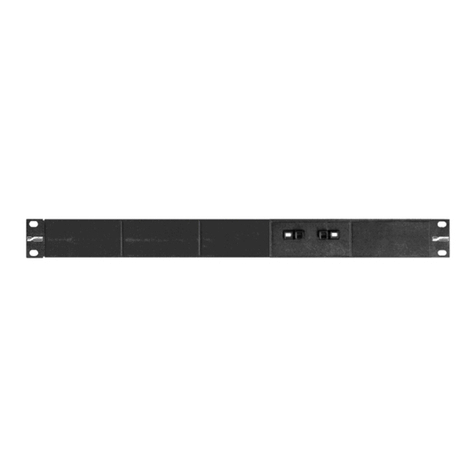
Ross
Ross RCS-8120 User manual

Ross
Ross MUX-8552A User manual

Ross
Ross softGear User manual
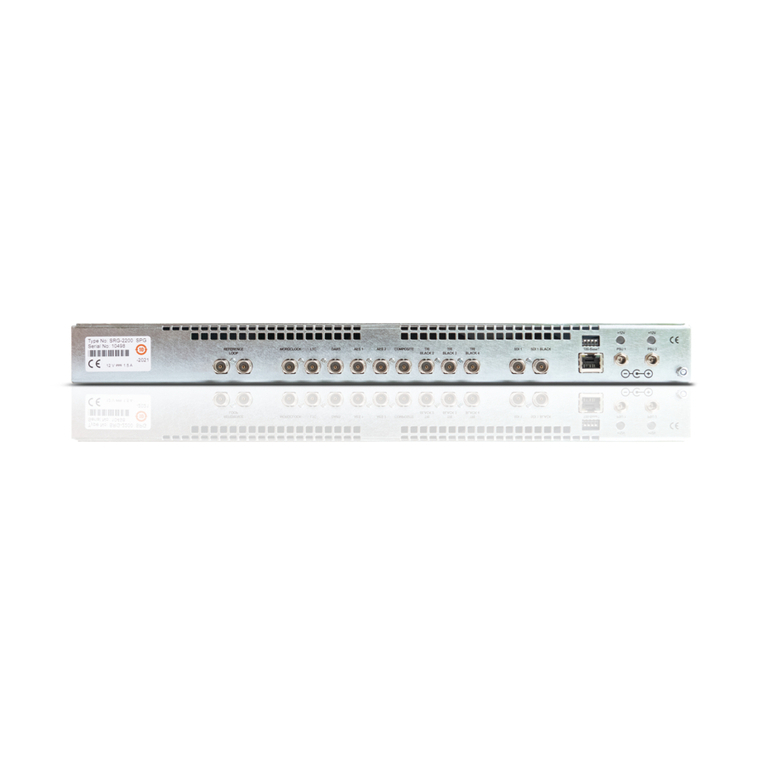
Ross
Ross SRG-2200 User manual
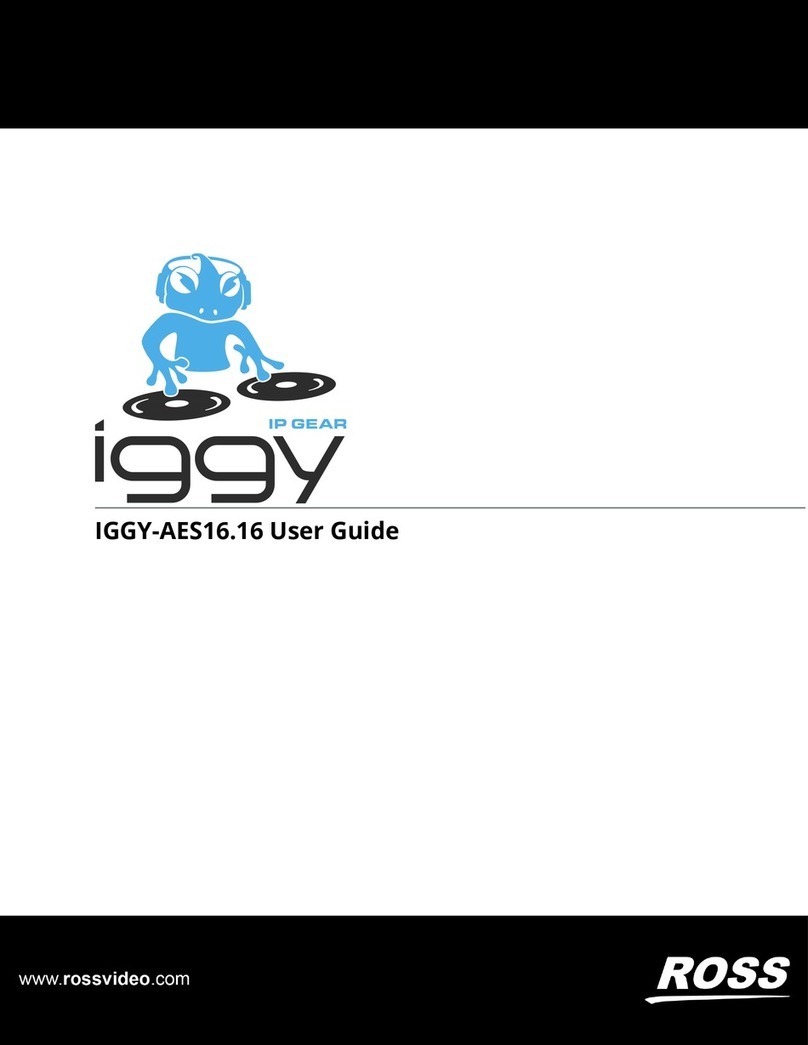
Ross
Ross IGGY-AES16-16 User manual

Ross
Ross XPression User manual

Ross
Ross MB-650 User manual

Ross
Ross NK Series User manual
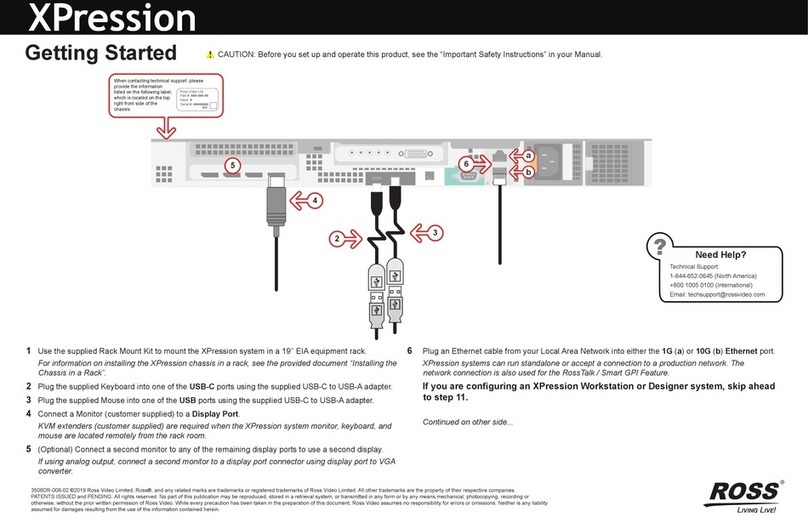
Ross
Ross XPression User manual
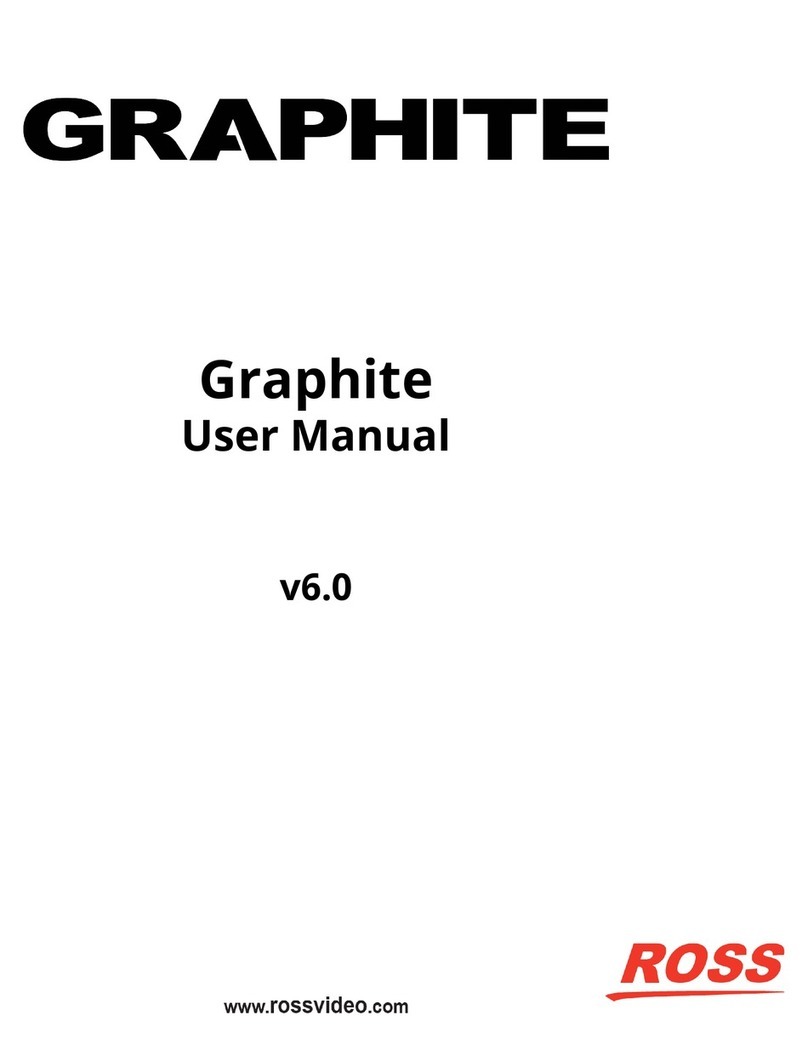
Ross
Ross GRAPHITE-4RU-1ME-9IN User manual



